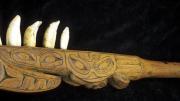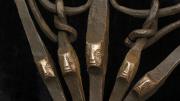Curator Steven A. LeBlanc has picked out the Peabody Museum’s most beautiful instruments of pain. Some 150 of these knives, daggers, swords, guns, maces, shields, helmets, spear-throwers, and assorted clubs are now on display in Arts of War: Artistry in Weapons across Cultures. They date from more than 5,000 years ago to the twentieth century, and represent every continent. The new exhibit (on view through October 2017) draws no absolute distinction between art objects, LeBlanc notes, and those designed purely to maim or kill: most are clearly both. “War in the past was much more pervasive and deadly than people realize,” the archaeologist adds, “and yet any of the evidence we have of weapons used throughout history shows that they were decorated.”
A wooden sword from a Kiribati warrior in the Pacific Islands is rendered more lethal with its graduated series of shark teeth, laced on with twined coconut fibers tightly woven into intricate patterns. The ivory base of a Persian dagger sports carved human figures, while a Balinese blade’s golden haft is studded with a star sapphire and rubies. Someone with taste certainly chose the dark gray stone with handsome natural striping that was honed and polished into a flat club used by the Maori people. “It’s so elegantly curved, so carefully made,” LeBlanc notes. “Would you think that it was a weapon?” It’s clear, he continues, mentioning the nose art on military planes flown by both sides in World War II, that people anywhere will decorate their weapons if given the chance, “which is rather counterintuitive.”
But is it? A club bludgeons an enemy, thereby keeping its wielder alive. Why wouldn’t a warrior personalize or imbue with protective spirits any armament? How could a weapon taken into bloody battles not act in some sense as a talisman? And wouldn’t a soldier want to differentiate his or her weapon from others—if only for practicality? “The exhibit does not pose theories about why,” LeBlanc asserts. “It asks you to think about it.”
Peabody Museum of Archaeology & Ethnology
Nov. 6, “Beautiful and Deadly: The Arts of War,” lecture by Steven A. LeBlanc











